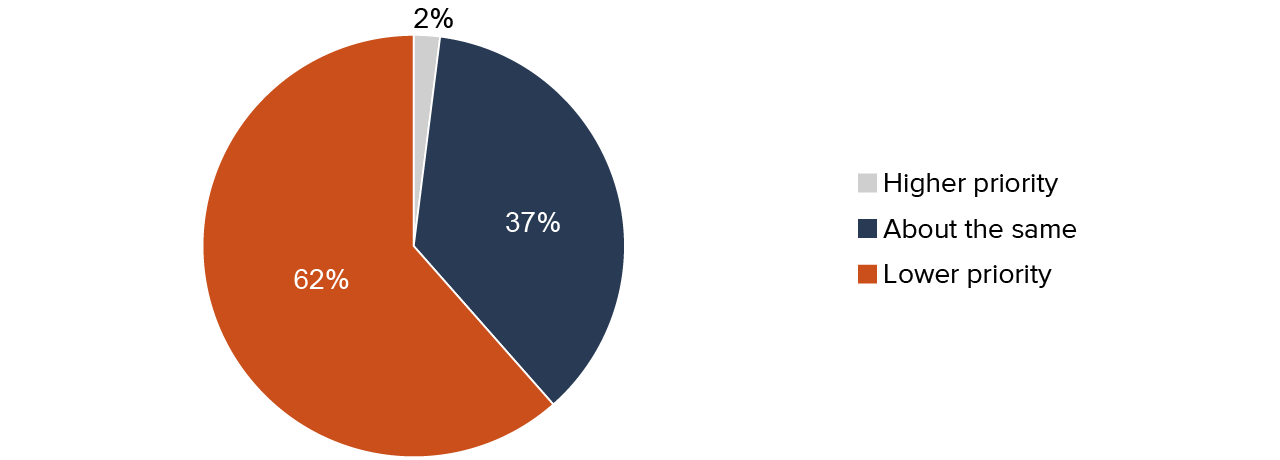California adopted the Next Generation Science Standards (CA NGSS) in 2013, with the aim of improving scientific literacy and strengthening the global competitiveness of the state’s workforce. By spring 2020, most California districts were in the early stages of implementing the new standards, and some districts were headed toward full implementation. But the COVID-19 pandemic has been especially disruptive for science education, which has long been a lower priority than math and English language arts.
COVID-19 derailed science education
Most districts deprioritized science during the pandemic. Science became a lower priority during the 2020–21 school year in most of the districts that participated in a PPIC survey. Key CA NGSS implementation activities, such as textbook adoption and course alignment, were delayed. Contributing factors included staff shortages, teacher burnout, a lack of dedicated funding, and an emphasis on English language arts (ELA) and math. However, some districts with large English Learner populations have been using science content to engage students in ELA and math.
Science became a lower priority in most districts in 2020–21

SOURCE: Authors’ calculations.
NOTE: Sample includes 213 respondent districts.
Support for science education was limited. During the 2020–21 school year, 60 percent of districts surveyed provided supplemental instructional materials, 43 percent provided summer science programs, and 40 percent addressed social-emotional learning in support of science education. Only a quarter of districts provided small-group instruction and very few offered extended science learning time during the regular school year. Only 40 percent provided additional science support to English Learners.
County offices of education received fewer requests for science-related assistance. During the pandemic, county offices created videos or webinars, provided technical assistance through virtual professional learning, continued to work with teacher leader networks, and shared grade-specific distance learning lessons. However, most county offices reported a decline in district requests for science professional learning or technical assistance.
Most district recovery plans do not prioritize science. Only 27 percent of the districts we surveyed made science a high priority in their recovery plans, whereas more than 80 percent prioritized math/ELA. Close to half of 2021–24 Local Control and Accountability Plans (LCAPs) included plans to adopt, develop, or purchase new science instructional materials; 38 percent included science teacher training, and 32 percent set performance goals on standardized tests.
Only about one in four districts reported that science is a high recovery priority

SOURCE: Authors’ calculations.
NOTE: Sample includes 213 respondent districts.
How can California promote equitable investments in science education?
As schools recover from the pandemic, California educators and policymakers should not lose sight of the need to invest in science literacy. The Next Generation Science Standards Systems Implementation Plan for California (2014) lays out eight strategies for equitable implementation—including the facilitation of professional learning, instructional resources, and new assessments. State and local agencies need to revisit these strategies and develop policies to support all students. We offer several recommendations:
- The state should include science in district accountability requirements. In part, science education became a lower priority because the state did not ask districts to address “pupil learning loss” in science in their Learning Continuity and Attendance Plans, and did not include science in its guidelines for spending stimulus money. Adding performance data for the California Science Test to the California School Dashboard will be a step in the right direction. However, the state should consider additional accountability measures—including local formative assessments, science course taking and completion, and a suggested range of instructional minutes in elementary schools—to avoid unintended consequences such as “teaching to the test.” The state could also add a line item for science education to LCAPs to encourage districts to engage multiple partners and develop programs that support all students.
- The state could provide dedicated funding for professional learning in science. Professional learning presents big challenges for CA NGSS implementation: most teachers were not getting the training needed to implement the new standards even before the pandemic. The state allocated $1.25 billion in Common Core Implementation Funds, and it could provide similar support for CA NGSS implementation.
- The state should provide evidence-based strategies for science learning recovery. State guidance for Elementary and Secondary School Emergency Relief (ESSER) and Expanded Learning Opportunities grants does not mention science; this may be discouraging districts from investing in science programs. The state needs to update its guidelines to include evidence-based science recovery strategies.
- Educational partners need to build a statewide coalition. Interviews with educational partners revealed concerns over a lack of urgency about science education. Science educators, parents, students, community-based organizations, and research communities can work together to highlight the importance of science literacy, increase awareness among policymakers, and secure resources for science education.
Topics
COVID-19 K–12 EducationLearn More

California Needs More Math and Science Teachers

Commentary: California Must Prioritize Science Education to Stay Competitive

Implementing the Next Generation Science Standards: Early Evidence from California

Prioritizing Computer Science in California Schools

